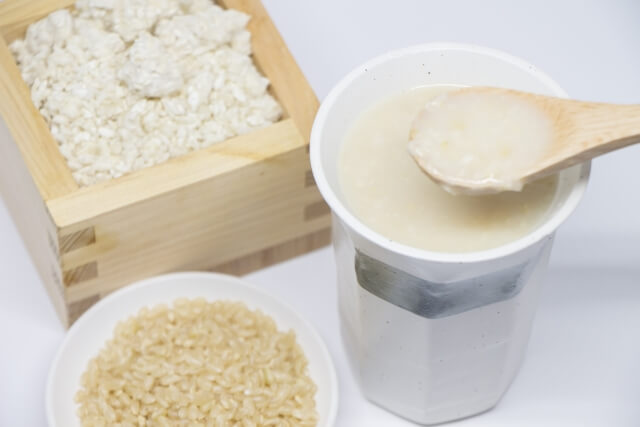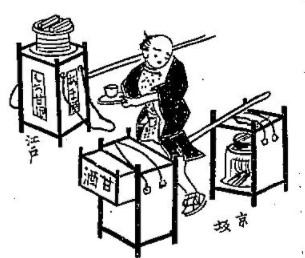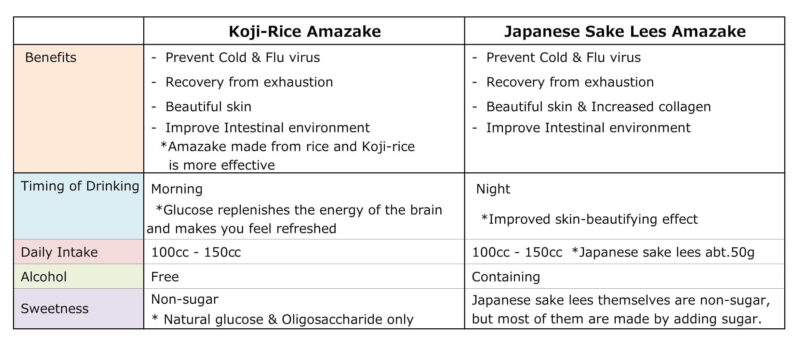
What is Amazake? Is Amazake liquor?
Amazake is a traditional Japanese sweet beverages. There are two types of non-alcoholic “Koji-rice Amazake” and “Japanese Sake Lees Amazake” with trace alcohol.
Koji-rice Amazake
Koji-rice Rice Water → fermenting ⇒ Koji-rice Amazake
Koji-rice Water → fermenting ⇒ Koji-rice Amazake
- Alcohol free
Japanese Sake Lees Amazake
Japanese sake lees Sugar Water → Boiling ⇒ Sake lees Amazake
- Low alcohol content
- Sake lees are the leftovers from Japanese sake brewing. It is full of rice and yeast nutrients.
- The alcohol content changes depending on the amount of sake lees, and if you drink a lot, you may get drunk.
- It seems that Japanese Sake Lees amazake are often served at shrines on New Year’s Eve and New Year.
- Depending on the region, there are Koji-rice amazake or Japanese sake lees amazake sold at stalls around shrines and temples.
- “Japanese Sake Lees Amazake” with less than 1% alcohol content is treaded as a soft drink and sold at supermarkets and stores in Japan.
Was Amazake a energy drink in the summer of the Edo period in Japan?
In the latter half of the Edo period (1781-1867), there is a book called “Morisada Manko” that records a comparison of the cultures and lifestyles of Kyoto, Osaka and Tokyo.
The book stated that in Kyoto and Osaka, Amazake hawkers were doing business throughout the town only on summer nights.

Looking at the illustration of the Amazake hawker, the hawker’s basket in Edo (Tokyo) has the word “mochi amazake”. “mochi” means sticky or glutinous rice, so it seems that it is amazake made from glutinous rice.
Also, there is a kettle in the hawker’s basket in Kyoto and Osaka, so it can be considered that they were selling warm food.
In order to restore physical energy that was consumed by the heat, Amazake sellers were on the market during summer, and everyone may have often taken it as a nutritional drink to prevent heat exhaustion.
By the way, Amazake is a summer season word in Haiku poem!
Is it really an nourishing drink?
During the fermentation process of Koji-rice, nutrients change in this way :
Rice starch → Glucose Oligosaccharide
Rice protein → Essential amino acids
B Vitamins (including 8 kinds of vitamins) → increase in large quantities
Glucose is the most important nutrient that becomes an energy source when humans and animals are active.
Amino acids are the constituents of protein. It includes essential amino acids of nine types of nutrients that cannot be produced by the body and must be ingested from food.
Amazake that contains these nutrients is called “drinkable IV” in Japan.
How can Amazake benefit our health?
Recovery from exhaustion
Since the nutrients of Koji-Rice Amazake have already been decomposed, it can be absorbed as it is without the action of digestive enzymes, and it is absorbed more quickly. Efficiently absorbs nutrients and switches to energy.
In addition, glucose and B vitamins are nutrients that have a high exhaustion recovery effect.
Prevent Cold and flu virus
Koji-Rice Amazake contains various nutrients such as glucose, oligosaccharides, and essential amino acids. These nutrients can serve as food for beneficial bacteria and improve the intestinal environment.
By adjusting the intestinal environment, immune cells can also be activated, suppressing the growth of harmful bacteria and bacteria, and protecting the body from viruses.
Beautiful skin
Koji-Rice Amazake contains glucosamine and ceramide, which are good for the skin, and has a beautiful skin effect.
Japan Sake Lees Amazake contains a component called α-EG (α-ethyl glucoside), which is effective in improving rough skin and moisturizing the skin.
A report of the latest study that the amount of collagen increased when examining the average value of collagen in people in their 40s and 50s who drank Japanese Sake Lees Amazake for a week (2018)
Quote: Moisturizing skin Moisturizing ingredient of Japanese sake lees
As a result of measuring the keratin water content in the drinking test of Japanese sake lees amazake, an increase in keratin water content was observed in the first week, and it became even larger in the second week. Even at low concentrations, α-EG accumulates in fibroblasts, increases the collagen density in the dermis layer, and penetrates into the stratum corneum of the epidermis. It was found that it is effective for firmness, luster and moisturizing of the skin.
Source: “Rejuvenates skin collagen with 50g a day! Japanese Sake lees BOOK for creating beautiful skin” from the article (P.8-9) by Professor/Doctor of Agriculture Kenji Ozeki of Kanazawa Institute of Technology 2018/2 published by Geibunsha
Improve Intestinal environment (Relieve Constipation)
Prolamin-derived indigestible protein “Resistant Protein” is not easily digested and absorbed like dietary fiber, and is excreted from the body, so it is expected to have an intestinal regulating effect.
Prolamin is a type of vegetable protein contained in seeds and grains (wheat, barley, corn, rice, etc.) and contains high levels of glutamic acid and proline.
Quote: “In humans, the effective amount of “prolamin”, which has a cholesterol-reducing effect and a stool-improving effect, is said to be about 113 mg / day. It was speculated that a cup (about 150 ml) of Koji-rice Amazake, which is made only from koji-rice and rice, contains the amount of “prolamin” that can exert its functionality in humans.
Source: “Drinking Aazake improves bowel movements, reduces cholesterol, and suppresses obesity” – University Press Center /Kanazawa Institute of Technology Department of Applied Biosciences Ozeki Laboratory demonstrates for the first time academically through joint research with companies / Kanazawa Institute of Technology 2018.04.06 https://www.u-presscenter.jp/article/post-39189.html
Summary

Reference lists
National Diet Library Digital Collections “Morisada Mankou” P.164(Frame #102/323) https://dl.ndl.go.jp/info:ndljp/pid/991466
“Rejuvenates skin collagen with 50g a day! Japanese Sake lees BOOK for creating beautiful skin” from the article by Professor /Doctor of Agriculture Kenji Ozeki of Kanazawa Institute of Technology P.8-9″ published by Geibunsha 2018/12
OZEKI Kinji Laboratory – Kanazawa Institute of Technology https://kitnet.jp/laboratories/labo0165/index.html
“Drinking Aazake improves bowel movements, reduces cholesterol, and suppresses obesity” – Kanazawa Institute of Technology Department of Applied Biosciences Ozeki Laboratory demonstrates for the first time academically through joint research with companies / University Press Center/Kanazawa Institute of Technology 2018.04.06 https://www.u-presscenter.jp/article/post-39189.html
“Fermentation is magic!” written by Takeo Koizumi, published by Nikkei Inc. 2014
“Question about fermentation and brewing 50” written by Tokyo Universty of Agriculture, Faculty of Applied Biochemistry, Department of Brewing Science/ published by Seizando-Shoten Publishing Co., Ltd.
Definition of “prolamin” by Medical dictionary https://medical-dictionary.thefreedictionary.com/prolamin
